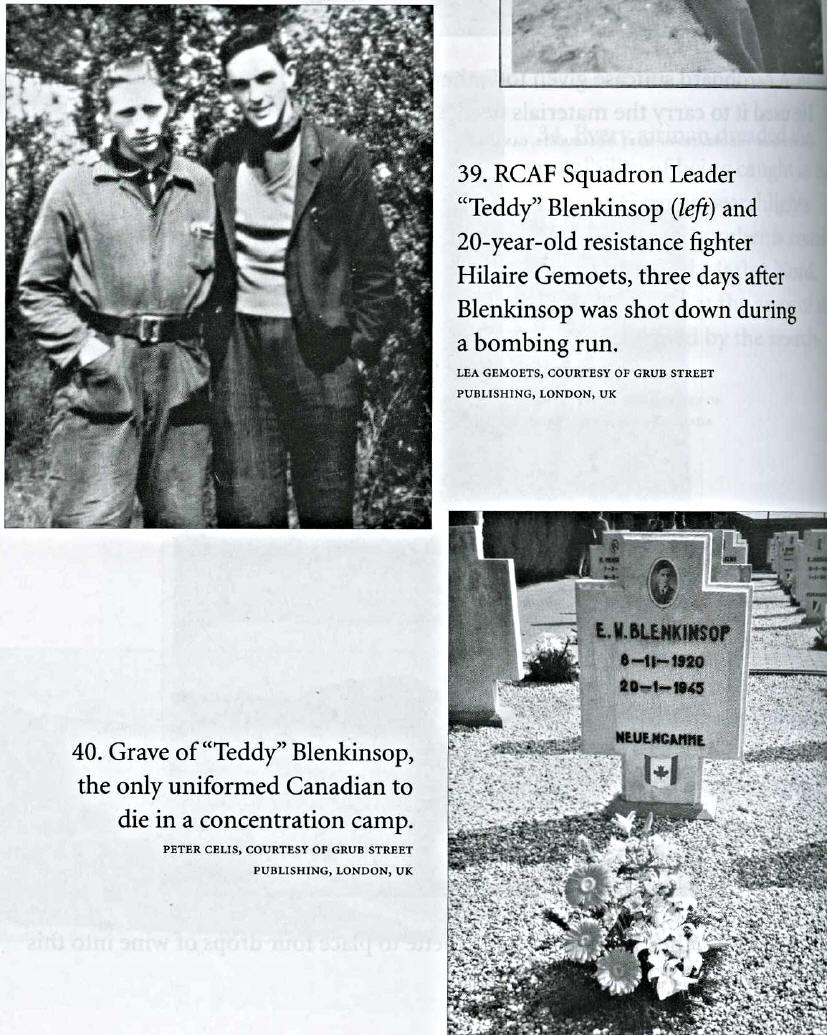
Squadron Leader Edward "Teddy" Blenkinsop, DFC, CdeG (Belge), RCAF.
Oak Bay Class of 37

The following article by Jack Knox was transcribed from the Victoria Times Colonist, November 11, 2008.
 Squadron Leader Edward "Teddy" Blenkinsop, DFC, CdeG (Belge), RCAF. Oak Bay Class of 37
|
Born in 1920 to a prominent Victoria family -- it's where Blenkinsop Road gets its name -- Edward W. Blenkinsop attended Craigflower and Monterey elementary schools, excelled as a swimmer, graduated second in his class at Oak Bay High. An apprentice accountant when the war broke out, he enlisted in the RCAF in 1940 and ended up piloting 30 bomber missions out of North Africa in 1943.
His star rose with a Pathfinder squadron leading raids out of England in 1944. His boyhood friend and commanding officer, the late Reg Lane (another highly decorated Victorian), later wrote that Blenkinsop was the "obvious choice" to take over the squadron.
But it was Lane himself who saw Blenkinsop's Lancaster, returning from a raid over southern Germany, burst into flames after being attacked by a Messerschmitt night fighter piloted by the German ace Johannes Hager. "It was with horror and shock that I watched him shot down," Celis quotes Lane as saying. "I was able to identify his plane by the colour of the pyrotechnics that blew up as his plane exploded. His and my airplanes were the only two carrying that colour."
In a piece written for Airforce Magazine, Celis describes how Blenkinsop, blown clear of the cockpit by the explosion, was the only survivor. The remains of the Lancaster came down on the Belgian village of Webbekom.
Blenkinsop was picked up by members of the Belgian resistance, who risked their lives to save his. Four farm families took turns hiding him for a week or two each before, in July 1944, he was taken in by a family in the rural town of Meensel-Kiezegem.
Sadly, Blenkinsop was caught, almost by accident, when German and Flemish SS troops raided the town that August in retaliation for the killing of one of their own. Four villagers were killed and 91 arrested; 71 of them, including Blenkinsop, were shipped to the Neuengamme concentration camp in Germany. Only eight survived the war.
Blenkinsop, accused by the Gestapo of co-operating with the resistance, was denied his rights as a prisoner of war. Pressed into forced labour in the shipyards and arms factories around Hamburg, his health failed during the winter of 1944. "Lacking medical care and adequate food . . . he died completely exhausted in January 1945," wrote Celis. Blenkinsop was cremated in the ovens of the Bergen-Belsen death camp, his ashes scattered as fertilizer.
But he wasn't forgotten. A grave marker in Meensel-Kiezegem bears his name. Celis, now 41, remembers accompanying his grandfather to the cemetery as a boy of nine or 10, remembers asking why one of the headstones bore a different flag. It was a Canadian pilot, he was told. Celis kept pestering his grandfather for more answers, finally ended up, at age 17, writing the Canadian Embassy.
That was the beginning of a 24-year project that resulted this year in the publication of The One Who Almost Made It Back: The Remarkable Story of One of World War Two's Unsung Heroes, Sqn Ldr Edward Teddy Blenkinsop, DFC, CdeG (Belge), RCAF.
Celis credits many Canadians, including Blenkinsop's cousins Brig. Gen. John Neroutsos and Dr. Philip Neroutsos, with helping him, but the fact remains that it was a Belgian who kept this Canadian's story alive.
Victoria's Atholl Sutherland Brown, another RCAF pilot who survived being wounded in the Second World War, says the Blenkinsop story is "very poorly known" here. Even Sutherland Brown, whose older brother Ian -- who also died in the war -- used to chum around with Blenkinsop, didn't know the tale until Lane told it to him about 10 years ago.
Happily, not everyone has forgotten Victoria's Teddy Blenkinsop. On Nov. 1, All Saints Day, the people of Meensel-Kiezegem put fresh flowers on his headstone, just as they do every year, just as they'll do again today.